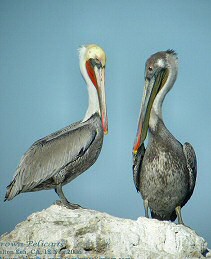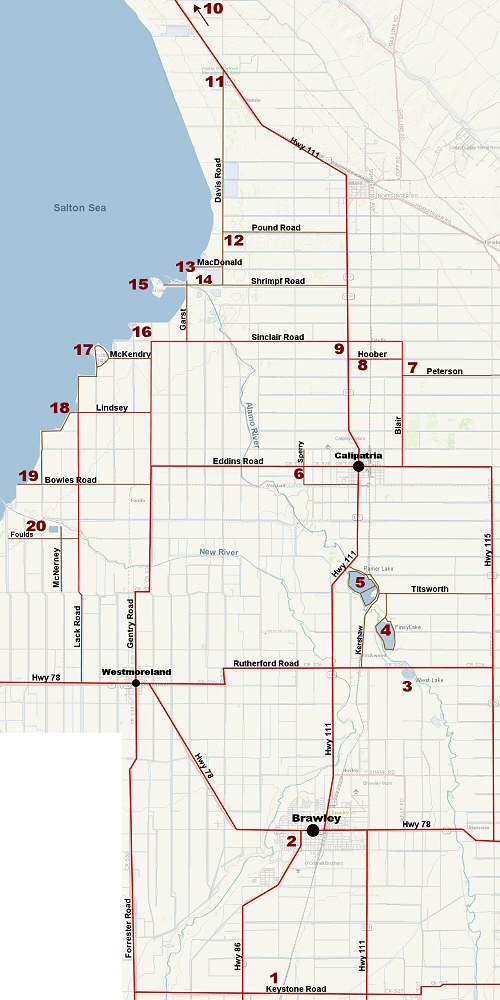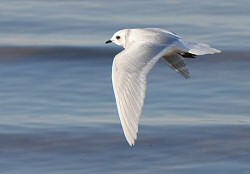Birding Site: Southeast Salton Sea Most recent visit: 7 May 2011
|
 Brown Pelicans |
|
Two hundred twenty-seven feet below sea level. Searing summer temperatures that exceed 115 degrees Fahrenheit. Largest lake in California. Saltier than the Pacific Ocean. Breeding Burrowing Owls, Ruddy Ground-Doves, Gull-billed Terns, Black Skimmers, and Laughing Gulls. A magnet for rarities, wanderers, and snow birds alike! These all describe the Salton Sea and the Imperial Valley. No matter the season, birders can spend a day around the Sea and find thousands of birds of a hundred-plus species. Every year sharp-eyed observers find unusual and choice birds to complement the numerous residents and migrants. Jaegers and scoters are an annual occurrence on the Sea. Fall 2006 saw a Ross’s Gull at Red Hill Marina and a Black-headed Gull at the north end of the Sea. Summer’s end may yield Magnificent Frigatebirds, Wood Storks, and Blue-footed Boobies. The list of rarities seen here over the years reads like a who’s-who of birds seen in all corners of the U.S. |
|
|
|
|
This route takes you to some of the finest birding in the southeast part of the Salton Sea and Imperial Valley. It covers riparian, agricultural, marsh, shoreline, and open water habitats. Good birding! |
1 |
East of Spreckels Sugar
- Access: from the intersection of Hwy 86 & Keystone, drive 1 mile east on Keystone - Habitat: agricultural fields, granary - Expected birds: Sandhill Cranes, raptors |
2 |
Cattle Call Park in Brawley - Access: from Hwy 86 & Cattle Call Road, drive 0.6 miles west on Cattle Call Road to entrance of park - Habitat: park with mixed trees, lawns, fields, and cattle pens - Expected birds: Vermilion and Gray Flycatchers, Red-naped Sapsucker - Bonus birds: Zone-tailed Hawk, Red-breasted Sapsucker |
3 |
Wiest Lake - Access: from Hwy 115 & Rutherford Road, drive 2.5 miles west to lake - Habitat: freshwater lake - Expected birds: waterfowl, Clark’s & Western Grebes, Gull-billed and other Terns - Bonus birds: Black Swift, Purple Martin |
4 |
Finney Lake - Access: from Titsworth & Smith, drive 0.5 miles south to entrance - Habitat: freshwater lake, marsh, brush, Athel Tamarisks - Expected birds: Clark’s & Western Grebes, bitterns, Marsh Wren, warblers, Crissal Thrasher, egret & heron colony - Bonus birds: Harris’s Sparrow, Chestnut-sided Warbler, Dusky-capped Flycatcher, Eastern Phoebe |
5 |
Ramer Lake - Access: from Kershaw & Titsworth, drive 0.6 miles north to entrance (left over RR tracks) - Habitat: freshwater lake, mixed woods, brush, marsh - Expected birds: Clark’s & Western Grebes, Marsh Wren, warblers, egret & heron colony, Vermilion Flycatcher - Bonus birds: Anhinga, Yellow-throated Warbler, Dusky-capped Flycatcher, Eastern Phoebe |
6 |
Eddins Road & Sperry Road - Access: from the from the center of Calipatria, drive 1.5 miles west on Eddins Road - Habitat: yards and farm - Note: be careful of fast cars on Eddins - Expected birds: Ruddy & Common Ground-Dove, White-winged & Mourning Doves, and Eurasian Collared-Dove - Bonus birds: Band-tailed Pigeon, Chestnut-sided Warbler |
7 |
Calipatria State Prison - Access: from Hwy 115 & Blair Road, drive 2.5 miles north - Habitat: freshwater pond, Bermuda grass fields (plover & longspurs) - Notes: pond is on south side of prison; fields are on east side of prison; - Expected birds: good mix of puddle and diving ducks, grebes, and gulls, in pond; Sprague’s Pipit; Lapland, Chestnut-colored, and McCown’s Longspurs in fields - Bonus birds: Smith’s Longspur |
8 |
Earthrise Spirulina Algae Farm |
9 |
Sinclair Road & Highway 111 - Access: from the center of Calipatria (Hwy 111 & Eddins), drive 3.5 miles north on Hwy 111, turn left on Sinclair - Habitat: Bermuda grass, plowed fields, dirt drains - Expected birds: Burrowing Owl (watching from the drains), Mountain Plover (especially in freshly burned or plowed fields), Sprague’s Pipit (in Bermuda grass) |
10 |
Salt Creek Beach - Access: 26.5 miles north of Niland, on west side of Hwy 111 - Habitat: freshwater creek emptying into the Salton Sea, open water, shoreline - Expected birds: Blue-winged Teal, Common & Red-breasted Mergansers, Common Goldeneye, and gulls - Bonus birds: Barrow’s Goldeneye, Tricolored Heron |
11 |
Wister Waterfowl Management Area - Access: 5.1 miles north of Niland on Hwy 111 (also reached by driving to the north end of Davis Road) - Habitat: riparian habitat, mesquite trees, fields, freshwater ponds, marsh, shoreline and open sea - Notes: short nature trail, restrooms, picnic area, and viewing tower - Expected birds: Snow & Ross’s Geese, “Yuma” Clapper Rail, Laughing Gull, Gull-billed Tern, sparrows, Abert’s Towhee, American Redstart - Bonus birds: Tropical Kingbird, Dusky-capped Flycatcher, Rufous-backed Robin, Ovenbird |
12 |
Davis Road - Access: ruins at corner of Davis & Pound - Habitat: ponds, ruined adobes - Expected birds: Snowy Plover, Peregrine Falcon, Say’s Phoebe |
13 |
McDonald Road - Access: from Davis & McDonald, drive about 1 mile west to end of road - Habitat: shoreline, hedgerow, open sea, ponds - Expected birds: waterfowl, Peregrine Falcon, Brant, shorebirds - Bonus birds: Roseate Spoonbill, Wood Stork |
14 |
Schrimpf Road |
15 |
Red Hill Marina |
16 |
Sonny Bono Salton Sea NWR Headquarters - Access: at the west end of Sinclair Road - Habitat: mesquite trees, fields, freshwater ponds, marsh, shoreline and open sea - Notes: half-mile nature trail, headquarters has bird info, restrooms, picnic area, and viewing tower - Expected birds: Snow & Ross’s Geese, Laughing Gull, Gull-billed Tern, Barn Owl, sparrows, Abert’s Towhee, shorebirds - Bonus birds: Long-tailed Duck, Eurasian Wigeon, Golden-crowned Sparrow |
17 |
Obsidian Butte - Access: from the refuge HQ, go south 0.5 miles south on Gentry, then west for 0.5 miles on McKendry to Obsidian Butte peninsula; loop road circles butte. - Habitat: marsh, ponds, saltbush, rocky shoreline and open sea - Expected birds: often best location for Yellow-footed & rare gulls, turnstones and other shorebirds, pelicans, waterfowl, Peregrine Falcon - Bonus birds: Heermann’s Gull, all three jaegers |
18 |
Salton Sea Levee (Sea Wall) - Access: south from Obsidian Butte; or from the west end of Lindsey Road—then follow it south about 4 miles to Bowles Road - Notes: fresh water flows from drains at various spots, like the end of drain at Young Road—these are excellent spots for waterfowl and gulls - Habitat: shoreline and open sea, freshwater inflows - Expected birds: grebes, waterfowl, gulls, terns, Peregrine Falcon, Merlin, “Large-billed” Savannah Sparrow - Bonus birds: scoters, rare ducks, pelagics, rare gulls, Reddish Egret |
19 |
Bowles Road - Access: from Bowles & Lack Roads, drive west 1.75 miles - Habitat: shoreline and open sea, freshwater mouth of the New River - Expected birds: exceptional numbers of waterfowl, gulls, terns, pelicans, Roseate Spoonbills, and waders - Bonus birds: Ruff, Little Gull |
20 |
Willey Reservoir - Access: from Lack & Foulds Roads, drive west 0.5 miles west to McNerney Road, drive 0.4 miles north on west side of ditch road to fenced perimeter of reservoir - Habitat: large freshwater reservoir - Expected birds: often the best mix of waterfowl in the Imperial Valley, gulls, and terns - Bonus birds: Surf & White-winged Scoters, Red-throated & Common Loons, Tundra Swan |
|
| Common Western waterfowl |
UncommonSurf Scoter (w)
| RareBlack Scoter (w)
|

